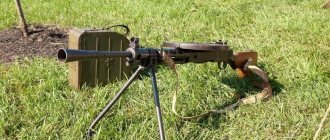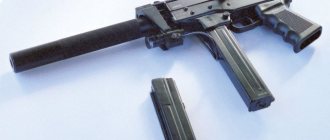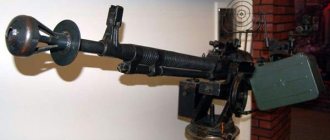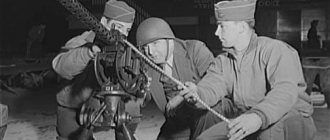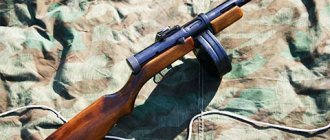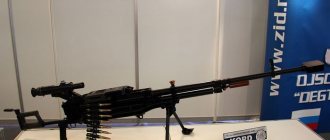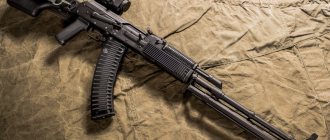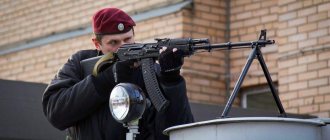DP light machine gun
After the end of the First World War and the Civil War, the small arms of the Red Army consisted of Mosin rifles and Maxim system machine guns; rare inclusions of Lewis and Shosh light machine guns did not make a difference. But at the same time, the modern concept of warfare required the presence at the squad and platoon level of mobile automatic weapons chambered for a rifle cartridge.
After the announcement of a competition for a light machine gun that would replace foreign models, the eminent gunsmith Vasily Alekseevich Degtyarev got involved in the work. In 1923, work began on the creation of a modern light machine gun, which was to become the group weapon of the squad and platoon. DP - Degtyarev infantry, became the first light machine gun of the Red Army, on the basis of which tank and aviation modifications were subsequently developed.
Making a machine gun
After an audit of the Red Army's weapons in the 1920s, commissions of auditors came to disappointing conclusions. The firearms fleet is worn out and also consists of a variety of weapons with different cartridges. If things were going well in the field of personal weapons, then foreign models were massively removed from service, replacing Winchesters and Arisakis with domestic rifle mod. 1895, the production of which was re-established in Tula. Nagan revolvers and Maxim machine guns were also produced in commercial quantities and there have been no problems with them yet.
Degtyarev infantry machine gun - photo
But a problem has arisen with light machine guns. Fedorov's assault rifles chambered for 6.5 mm Arisaka, British and American Lewis, French Hotchkiss and Shoshi were thoroughly worn out. Repairs and replacement of weapon components were required.
In 1923, a competition was announced to create a new light machine gun for the Red Army, in which eminent masters Fedorov and Tokarev, as well as V.A. Degtyarev. In 1924, Tokarev's design was adopted. At that time, the MT-25 machine gun based on Maxim was satisfied with the leadership of the Red Army, but Degtyarev’s machine gun was returned for modification.
After completion, Degtyarev again presented the developed weapon to the commission. This time the characteristics of the machine gun suited the military, and Degtyarev infantry was accepted for the next test. After the January tests in 1927, the army immediately ordered a batch of machine guns for military testing, after which the machine gun was recommended to be put into production and at the same time put into service with the Red Army under the name DP.
DP was produced at the Kovrov plant until 1944, before being replaced by DPM and later by RPD. After the war, outdated, but still relevant, machine guns were transferred to the troops of fraternal countries, and the DP-27 fought in the jungles of Korea and Vietnam. It showed itself well in combat operations in the equator zone and desert-mountainous areas.
Degtyarev light machine gun RPDH-SKh (RPD-44, ZiD) 7.62×39
Packaged dimensions: 1240 x 170 x 105 mm
Shipping weight: 8,190 g
Characteristics:
| Manufacturer: | JSC "Plant named after. V.A. Degtyareva" – ZiD (Kovrov, Russia) |
| Caliber: | 7.62 mm |
| Combat prototype: | Degtyarev RPD-44 light machine gun (USSR/Russia) |
| Ammunition: | light and sound cartridges 7.62×39 |
| Magazine capacity: | 100 |
| Blowback (?): | Yes |
| Material: | steel, wood |
| Shooting mode (?): | auto |
| Dimensions: | 1040x180(270)x69 mm |
| Weight: | 7610 / 6840 g - without magazine (8190 g - in packaging) |
| Peculiarities: | folding bipod, auto fire |
| Equipment (?): | light machine gun, cartridge drum, cartridge belt, cleaning rod, passport (instructions), box (or without it in the bag) |
| Certificate: |
Description of the degtyarev RPDH-SKh machine gun:
RPDH, Degtyarev light machine gun, is a light-type combat machine gun, converted to fire blank cartridges in automatic mode. This weapon was in service from the end of World War II until the mid-sixties.
Degtyarev's RPDKH-SKH (RPD-44) light machine gun, was depleted by the SHP , is a weapon converted from a military weapon that fires blank cartridges. The combat prototype of this modification was developed by V.A. Degtyarev in 1944, and was then called RD-44. At first, the weapon was produced in a small batch, but after testing by the troops and some modernization, the RPD-44 machine gun was put into service in 1945.
A special feature of this light machine gun is the use of belt feeding; the cartridges are in two belts of 50 pieces each. This provided the weapon with high mobility and made it possible to increase the rate of fire. The absence of springs in the magazine increased the reliability of the machine gun. Until the end of the 50s, the RPD-44 remained in service, then it was gradually replaced by the RPK. The machine gun was exported to other countries of the Soviet camp, and even produced in China. A number of American companies still produce modernized versions of the RPD-44.
The deactivated Degtyarev light machine gun is designed to fire 7.62x39 ammunition, which is fed from a belt, and the cartridges exit through the ejector. Auto fire mode is used. The RPD has two fuses: one is a flag type, with two working positions, the second is in the form of a bar designed to block the trigger. This modification includes a bipod with a locking mechanism, which provides the weapon with mobility and high efficiency in both defense and offensive operations.
The appearance of a deactivated RPD is no different from a real military weapon. Critical components, the base, body and bolt are made of weapon steel, the butt of the weapon is wooden. The disassembly and assembly process is similar to the combat prototype. When firing blank ammunition, it must be taken into account that fire erupts when fired at a distance of up to 1.5 meters, and carelessness can lead to burns.
During the process of deactivating the RPD, the following changes were made:
- pins are installed in the receiver;
- Some steel was removed from the receiver by milling;
- The bolt is equipped with elements that respond to the milling of the receiver.
The cooled RPD-44 is suitable for use for patriotic and educational purposes, for filming and performances, and reconstruction of historical battles. Such a specimen will be a successful addition to any weapons collection.
Video review:
Information about the characteristics, configuration, appearance and color of the product is for informational purposes only.
; they are subject to change by the manufacturer without notice.
In the online store pnevmat24.ru you can buy the Degtyarev RPDKH-SKH (RPD-44, ZiD) 7.62×39 SHP light machine gun with convenient delivery throughout Russia by courier, transport company or Russian Post. We also deliver to Belarus. You can check the price and order the product on the website, by phone or write an e-mail.
RPD model 1943
In 1944, a new weapon was developed, called the RPD - the Degtyarev light machine gun, chambered for the 1943 model. In the same year, an experimental batch was released for military testing. The RP-44 or RPD machine gun had a belt ammunition supply from a metal box suspended from the machine gun body with a standard belt for 100 rounds.
RPD model 1943
The same tape went to the Goryunov machine gun, model 1943. The machine gun differed from earlier models in the presence of a pistol grip, a volume-shaped butt for ease of holding it when shooting, and the presence of a wooden fore-end with stops to hold the body of the machine gun when shooting in weight.
In the future, after the adoption of the AK-47 assault rifle and the SKS carbine, it was the RPD that was the first handbrake included with them. Subsequently, the RPD was replaced by the Kalashnikov light machine gun. It just so happened that the requirements of unification forced the Degtyarev light machine gun to be removed from service.
RPD characteristics:
- Cartridge 7.62x39 (7.62 mm model 1943)
- Machine gun weight without cartridges 7.4 kg
- The weight of the machine gun with a loaded cartridge box is 9.8 kg
- Machine gun length 1037 mm
- Barrel length 520 mm
- Initial bullet speed 735 m/s
- Muzzle energy 2134 J
- Sighting range 1000 m
- Rate of fire 650-750 rounds/min
- Combat rate of fire 150 rounds/min
- Belt capacity 100 rounds
- Weight of cartridge box with tape 2.4 kg
Long before Minimi
In the last quarter of the 20th century, the Belgian FN Minimi machine gun began its triumphal march through the armies of the world. However, there were also those who, for some reason, did not want to get involved with the new product. For example, in Israel, which was previously among the fans of Belgian small arms, they preferred to develop their own Negev machine gun of a similar class and purpose. Even more interesting is that Israel could have received almost the same light machine gun chambered for an intermediate low-pulse cartridge much earlier, and visual evidence of this fact is in the Israel Defense Forces Museum. It is there that the Soviet RPD light machine gun, converted to the standard NATO 5.56x45 mm cartridge, is stored. However, the Degtyarev light machine gun did not go into production the easiest way.
Throughout the Great Patriotic War, the niche of the light machine gun in the Red Army was occupied by the Degtyarev machine gun of the 1927 model. For its time, it had fairly high tactical and technical characteristics, but, unfortunately, its main opponent, the German MG 34 and MG 42, already belonged to a different class of single (universal) belt-fed machine guns. Attempts by Soviet designers to create a similar machine gun chambered for the standard 7.62x54R rifle cartridge in those years were unsuccessful, although some samples submitted for testing seemed very promising.
A variant of the modern modernization of the RPD-44 from the American company DS Arms
The situation changed dramatically after the appearance of the 1943 model cartridge. The characteristics of the new ammunition for creating automatic systems were noticeably better than those of the “difficult legacy of the tsarist regime.” It is interesting that at the beginning of the work it was planned to put into service a combination of a “heavy machine gun” and an “automatic carbine”. For the machine, in particular, it was indicated:
“The total weight of the machine gun with a bayonet, magazine, belt and accessories should be no more than 5.0 kg ...
The length of the machine gun without a bayonet should be 900 - 1000 mm, and with a bayonet - 1200 - 1300 mm... The machine gun should have a light bipod, which when folded form should not protrude sharply from the dimensions of the machine gun and should allow shooting while standing and kneeling .
It is interesting that the Kalashnikov light machine gun, which appeared in the second half of the 1950s, created on the basis of the famous machine gun, fit into these wishes quite well, but in 1944 it turned out differently. In the first half of the year, samples of “heavy machine guns” began to arrive at the test site. Of course, at that moment the very terms “machine gun,” and even more so, “heavy machine gun,” were quite vague, but some samples were clearly being handled with difficulty.
For example, the KB-P-315 sample developed at Degtyarev KB-2 even outwardly resembled the well-known DP - 50 rounds were loaded into a disk magazine attached to the top. At the same time, the model designed by Korovin was even heavier than that of the Degtyarev team. Another experimental “machine gun” from KB-2 had belt power. In his “Notes of a gunsmith tester” A.A. Malimon wrote:
“Commissions of A.Ya. Bashmarin had to disassemble the presented samples by type of weapon. Samples of Degtyarev with a tape and a disk magazine, Simonov and Korovin were immediately classified as light machine guns, even before the tests began.” .
However, regardless of the classification of the samples provided, they still had to be brought to fruition. In terms of the reliability of the automation, none of them met the tactical and technical requirements of the customers from the Main Artillery Directorate of the Red Army (GAU KA). The number of failures (delays) even under normal operating conditions was in the range of 0.71–1.05%, while no more than 0.3% was allowed. The Korovin sample had the smallest number of delays, and the Degtyarev sample with belt feed had the greatest number of delays. Only the above-mentioned sample with the disk reached the end of the survivability tests.
Experienced machine gun KB-P-315 with disk magazine
Nevertheless, it was the belt-fed sample from KB-2 that was recommended for modification to the light machine gun version, along with the Simonov and Korovin variants. It probably played a role that by this time the GAU KA had accumulated a solid stock of negative reviews from the front about “pancakes”. In addition to their significant “dead weight,” the discs were criticized for their lack of strength in real war conditions, as well as their high sensitivity to contamination.
But even on the second attempt, the machine gun, identified in the documents as KB-P-310, failed to take the line of the training ground. In the second round of testing, the automation failed again, giving 0.64–1.23% delays. In addition, the testers' conclusions drew attention to the difficulty of cleaning gas passages. Also about
. Finally, another problem was the rammer breaking off from the cartridge being rammed.
In October 1944, the third version of the new machine gun arrived at the GAU KA shooting range. During the modification, the KB-P-310's gas paths were changed to make them easier to clean, the cutoffs were strengthened by introducing heat treatment, and bullet guides were installed on the receiver tray. At that moment, the future RPD-44 had the following characteristics:
- machine gun weight with bipod and without magazine - 6.34 kg;
- magazine weight without tape - 0.70 kg;
- belt weight with 100 cartridges - 1.86 kg;
- machine gun weight in firing position - 8.90 kg;
- machine gun length - 1027 mm;
- barrel length - 520 mm;
- sighting line length - 776 mm;
- travel of moving parts - 138.5 mm;
- rate of fire - 600–650 rounds per minute;
- target firing range - 1000 m;
- locking - DP type.
Archival photo of an experimental machine gun from tests in April 1945
In factory tests, the modified machine gun produced 0.06% delays and 0.01% breakdowns. At the training ground, the third attempt also turned out to be more successful than the previous one. The only serious comment was the desire to eliminate the possibility of incorrect assembly of the gas regulator - in the prototypes this possibility was present, and in this form the regulator blocked the gas paths. However, it was proposed to make these changes already in the process of manufacturing the series for military testing. Usually the story about this stage of creating a RPD ends with the phrase:
“The Degtyarev RPD-44 machine gun chambered for the 1943 model passed field tests and can be recommended for series production for submission to military trials.”.
Meanwhile, in the first half of 1945, quite important events took place in the fate of the machine gun. In March, two RPD-44s from the first production batch were delivered to the GAU KA shooting range. It is noteworthy that they were tested by the author of the above-mentioned memoirs, A.A. Malimon, then senior technical lieutenant.
The test results were, to put it mildly, not encouraging. Both machine guns failed them, showing unsatisfactory operation of the automation, as well as low survivability of parts. In addition to the already familiar problems with chambering the cartridge, one of the machine guns also demonstrated a new “disease” - the cartridge flying out of the belt. As a result, the conclusion of the test director read:
“Due to identified deficiencies, the manufactured series of RPD-44 machine guns cannot be approved for military testing.”
In 1945, there was no Internet yet, and therefore there was no joke about how, when hacking the Pentagon server, Chinese hackers, on the 7578642875th attempt, convinced an American computer that its password was “Mao Zedong.” However, this did not stop Soviet people from practicing similar methods in their work, albeit on a smaller scale.
Soldier of the People's Army of the GDR with RPD-44
The next two machine guns arrived at the test site in April. No documentation about the debugging work was provided - according to the plant representative, the presented machine guns had an increased protrusion of the rammer above the base of the receiver. It cannot be said that this significantly helped in obtaining the coveted admission. One of the machine guns, due to constant failures of the rammer during preliminary firing, was not allowed to be tested at all, and the second was rejected due to low survivability of the bolt.
In May, four RPD-44 machine guns of the first series arrived at the training ground from KB-2. At the same time, as follows from the documentation provided, no work was carried out at the plant to eliminate problems with re-sending. Two of the presented machine guns had an extended regulator groove, but that was all the modifications were limited to.
Of course, no miracle happened with this approach - the tests failed due to the same delays due to the failure of the rammer and incomplete recovery of the moving parts. A separate paragraph of the report was devoted to problems with cleaning, which were noted back in 1944, with the second appearance of the new machine gun at the test site.
Nevertheless, machine guns of this series still managed to get to military tests. According to the order of the NPO dated June 16, 1945, the GAU KA, together with the Infantry Inspectorate, organized extensive military tests of new prototypes of small arms. Among others, the RPD-44 of the first series went to the troops. This happened, as can be seen from the date, after May 9, so the statements found in some publications that the RPD-44 managed to fight on the fronts of the Great Patriotic War are a consequence of the banal illiteracy of the authors - they say, if the machine gun is from 1944, then in 1945 it had to make it to the front.
Soviet marines with an RPD machine gun
Meanwhile, the result of post-war military tests, taking into account the above, was quite expected. Having studied the feedback from the troops, the test organizers decided that the machine gun in its current form could not be recommended for adoption. Improvements were required on the following points:
- eliminate the loss of cartridges from the belt links when firing;
- change the gas paths, ensuring less contamination of them with powder gases, a more convenient rearrangement of the gas regulator and a sufficient impulse of the powder gases;
- provide a more favorable ratio between the masses of the bolt and bolt frame;
- increase the survivability of machine gun parts that have shown unsatisfactory survivability in production models;
- change the mounting of the barrel in the receiver in order to ensure the possibility of replacing it in military workshops;
- eliminate the possibility of the recoil spring spontaneously jumping out of the butt socket;
- provide the ability to close the receiver cover in any extreme position of the shutter;
- reduce the number of accessory parts, mount an oiler in the butt and make the cleaning rod one-piece.
The long work of “bringing to mind” the RPD lasted several more years. In fact, the machine gun with the numbers “44” in the index was adopted for service only in 1948, and began mass production in 1949.
Concluding the story about the birth of the RPD, it is worth saying a little about its creators. Coma of V.A. himself Degtyarev, V.N. took part in the development of the KB-P-310 machine gun. Ivanov, P.E. Ivanov and N.A. Bugrov, subsequently E.K. joined in the finishing work. Alexandrovich, G.F. Kubynov and a number of other employees of KB-2.
Sources and literature:
- Documents of GAU KA (TsAMO RF)
- Malimon A.A. Domestic assault rifles (notes of a gunsmith tester) - M.: Ministry of Defense of the Russian Federation, 2000
- Encyclopedia of Kovrov weapons, 1918-1966: based on materials from the architect. KB "Armatura" - M.: "Fiction", 2012
DP
The DP light machine gun (Degtyarev infantry machine gun) is a weapon with automatic operation based on the removal of powder gases and magazine feed. The gas engine has a long stroke piston and gas regulator located under the barrel.
The barrel itself is easily removable, partially hidden by a protective casing and equipped with a conical removable flash suppressor (early releases did not have a flash suppressor, nor did they have threads on the barrel for it). The barrel sometimes could not withstand intense fire: since it was thin-walled, it quickly heated up (especially on later releases, in which, for simplicity, the barrel was made without a ribbed radiator), and in order not to disable the machine gun, it was necessary to fire in short bursts (combat machine gun rate of fire - up to 80 rounds per minute). Changing the barrel directly during combat was difficult: it required a special key to remove its lock and protect your hands from burns.
DP
The barrel was locked by two lugs, moved to the sides as the firing pin moved forward. After the bolt comes to the front position, the bolt frame continues to move, while the widened middle part of the firing pin connected to it, acting from the inside on the rear parts of the lugs, moves them apart into the grooves of the receiver, rigidly locking the bolt.
After the shot, the bolt frame begins to move backward under the action of the gas piston. In this case, the firing pin is pulled back, and special bevels of the frame bring the lugs together, disengaging them from the receiver and unlocking the bolt. The return spring was located under the barrel and during intense fire it overheated, losing elasticity, which was one of the relatively few but significant disadvantages of the DP machine gun. In addition, the lugs required precise adjustment to achieve symmetrical locking (which did not pose a significant drawback in practice).
DP-27 light machine gun
The food was supplied from flat disk magazines - “plates”, in which the cartridges were located in a circle, with bullets towards the center of the disk. This design ensured reliable supply of cartridges with a protruding rim, but also had significant disadvantages: large dimensions and weight of an empty magazine, inconvenience in transportation and loading, as well as the possibility of damage to the magazine in combat conditions due to its tendency to deform. The magazine capacity was initially 49 rounds; later 47-round cartridges with increased reliability were introduced. The machine gun was attached to three magazines with a metal box for their transportation.
It should be noted that, although the DP magazine externally resembles a Lewis machine gun magazine, in fact it is a completely different design in terms of its operating principle; for example, in the Lewis, the cartridge disk rotates due to the bolt energy transmitted to it by a complex system of levers, and in the DP, due to a pre-cocked spring in the magazine itself.
RPD-44 machine gun
The machine gun's trigger mechanism allowed only automatic fire from an open bolt. It is located in the trigger frame, attached to the receiver with a transverse pin. There was no conventional safety; instead, there was an automatic safety in the form of a button, which was turned off when the hand covered the neck of the butt. When conducting intense fire, the need to constantly hold the safety button pressed tired the shooter, and the rifle-type stock did not contribute to a strong hold of the weapon when firing in bursts. The trigger frame of the DT tank machine gun, which had a conventional safety and a pistol grip, turned out to be more successful. The modernized version of the machine gun - DPM - received a similar design of the trigger frame. It is also interesting to note that a non-automatic fuse, in addition to the native automatic one, was introduced into the design of Finnish DPs during their overhaul.
Fire from the Degtyarev infantry machine gun was carried out from a removable bipod; in the heat of battle, the bipod was sometimes lost due to poor fastening or became loose, which, in turn, significantly worsened the ease of use and stability of the machine guns. Therefore, a non-removable bipod was introduced on the DPM. The spent cartridges were ejected downward.
DP characteristics:
- Caliber - 7.62;
- Weight with magazine - 8.4 kg;
- Total length - 1266 mm;
- Magazine capacity - 47 rounds;
- Sighting range - 1500 m;
- Rate of fire - up to 80 rounds per minute.
Delivery set of RPD SKh
- Decommissioned machine gun RPD SKhP - 1 pc.
- Cartridge box - 1 pc.
- Cartridge tape (for 100 rounds, consisting of two parts of 50 links each) - 1 pc.
- RPD CX passport - 1 pc.
- Packaging - 1 pc.
- Cleaning rod - 1 pc. (The first trial copies will not be completed).
Operating principle of RPD SKh ZiD
Automatic operation is possible due to the recoil of the free shutter. The barrel bore is locked due to the large mass of the bolt frame and bolt in particular and the force of the return mechanism in the form of a coiled spring. The impact mechanism in the cooled RPD is driven by a return spring; the mechanism, by the way, is of the striker type.
Because the machine gun is made from a combat model of the Degtyarev light machine gun, then all the mechanisms, barrel, bolt frame, bolt, etc. made of weapons-grade steel, to familiarize yourself with the method of assembling/disassembling a machine gun, check out the video review of a cold RPDH made by the Popadiv10.ru store.
The passport for the machine gun pays great attention to safety precautions, namely:
- It is not recommended to point cold weapons at people, especially at law enforcement officers, in order to avoid the use of firearms against the owner of a machine gun.
- Use only recommended 7.62x39 Blank cartridges for shooting ( 100 rounds )
- Do not point a loaded, cold weapon at people to avoid causing damage (Smoke and fire come out of the barrel in full, since the cross-section of the barrel is blocked by only 40%, the fire comes out of the barrel at a distance of up to 1.5 m).
- Do not shoot in crowded places or crowded places (rallies, parades, discos) in order to avoid administrative measures being taken against you.
The Degtyarev SKhP light machine gun is equipped with a safety lock; it is located above the trigger on the machine gun body. During shooting, just like in combat, the spent cartridges do not fall down, but go to the right along with the cartridge belt.
The model is equipped with a folding bipod with a locking mechanism reminiscent of a bipod from the RPK. Unlike the DP 27 SH infantry machine gun, the RPD is more convenient to use and could be used as an offensive weapon with the same effectiveness as a defensive one.
Some historical facts about the combat RPD 44
The destructive power of the machine gun was 800 m, which fully satisfied the needs of the Soviet army at that time. The model is equipped with a belt feed, consisting of 2 pieces of 50 charges of 7.62x39 caliber; the charged tape was loaded into a round box (drum), fixed on the machine gun body.
The model was in service from the end of World War 2 until the mid-60s, and was one of the first models chambered for low-impulse cartridges, used by the troops of both the USSR and other countries.
DT
The Degtyarev tank machine gun (DT) entered service with the Red Army in 1929 under the designation “7.62-mm tank machine gun of the Degtyarev system mod. 1929" (DT). It was essentially a modification of the 7.62 mm DP light machine gun designed in 1927. The development of this modification was carried out by G.S. Shpagin, taking into account the peculiarities of installing a machine gun in the cramped fighting compartment of a tank or armored car.
Degtyarev tank machine gun
Instead of a wooden butt, a retractable metal one was installed. The standard bulky single-row magazine has been replaced with a three-row magazine that holds 63 rounds.
DT-29
The machine gun was mounted on a ball mount developed by G.S. Shpagin, which made it possible to easily aim the machine gun in horizontal and vertical planes. The machine gun was also equipped with a canvas casing catcher.
At the end of 1935, a 2.5x optical sight began to be installed on the DT; in February 1936, plant No. 185 developed a pivot mount for the DT machine gun (produced in small quantities); in 1937, the P-40 turret mount was developed for the DT; in 1938 - turret mount P-40-UM.
Characteristics of DT-29:
- Caliber - 7.62 mm, cartridge 7.62x54mm.
- The initial bullet speed is 840 m/s.
- Length - 1250 mm.
- Barrel length - 605 mm.
- Weight in firing position: 10.5 kg.
- Technical rate of fire: 600 rounds/min.
- Combat rate of fire -120 rounds/min.
- The disk magazine capacity is 63 rounds.
- The target firing range is 1000 m.
Combat use
The first case of combat use of the DP machine gun took place in 1929, during the fighting on the Chinese Eastern Railway. The DP infantry machine gun was installed on small torpedo boats of the G-5 type as a self-defense weapon (for firing at sea mines, low-flying aircraft and other targets).
During exercises and combat operations, the machine gun was serviced by two people: the shooter and his assistant, who carried a box with 3 disks. Also, when shooting from a prone position, a long ribbon was tied to the machine gun at both ends, and the fighter, pulling it with his foot, pressed the butt harder to his shoulder. Thus, the vibrations of the machine gun were reduced and the shooting accuracy increased.
Degtyarev tank machine gun
The DP machine gun was installed on M-72 motorcycles. The design of the attachment of the machine gun to the sidecar made it possible to fire even at airplanes. However, this method of fighting aircraft was not very convenient: to shoot, it was necessary to stop, then the fighter got out of the wheelchair and fired at air targets from a “sitting” position. After the adoption of the DP machine gun, the British Lewis machine guns of the 1915 model, which had previously been in service with the Red Army, gradually went into storage.
It is worth noting that in addition to machine guns, the Degtyarev submachine gun was also produced.


